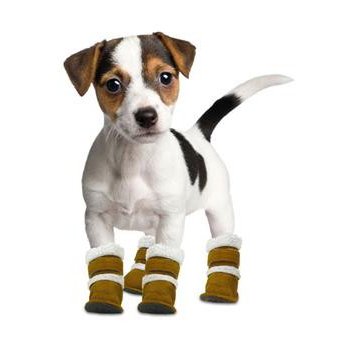Say the words “dog booties,” and images of pampered lapdogs in snazzy pink high tops may spring to mind. To many dog owners, canine footwear seems about as necessary as those Hermès collars.
But believe it or not, booties aren’t just for dogs who own more accessories than you. Canine feet may be tough, but certain conditions–extreme heat or cold, rough terrain, or just a lot of running on pavement–can cause serious wear and tear. In these case wearing boots can help keep your dog out of pain and on the go.
Does my dog need boots?
Think about what your dog walks on.
Do any of the following apply?
- You live in a cold climate where salt or chemicals are put on streets and sidewalks to melt the ice. Not only can salt and ice-melters irritate paws, they can cause stomach upset when your dog licks her feet. Note: You don’t necessarily need to buy boots for this; you can also rinse your pup’s feet in warm water after wintertime outdoor walks.
- Your dog walks on hot pavement in summer
- Your dog walks and runs–a lot.
- You often take your dog over rough terrain, subjecting her tootsies to jagged rocks, thorns, burrs, and foxtails
- Your dog’s healing from a paw injury
- You want to keep your dog from scratching herself
Take a look at your dog’s feet. Many dogs aren’t crazy about having their feet handled, so be slow and gentle and praise her to the skies if she cooperates. Look for these warning signs that her paws are getting beat up:
- Blisters, burns, or swelling
- Cracks or cuts
- Redness
- Seeds and burrs stuck between the paw pads
Gently press on your dog’s paw pads. Wincing or yelping is a sign of tender, sore feet.
If your pup’s lifestyle is tough on her feet, and her paws are showing the signs of it, consider buying her dog booties.
What kind of boots should I get?
You’ve got a lot of options. Think about what kind of conditions your pup will be walking in, then bring her to a pet supply store and try on a few. You can also find boots online–some makers will even customize them to fit.
Here are some things to consider:
- Do they fit? They should be snug enough to stay on, but not so tight that they cut off circulation.
- Do they stay on? Let her do some practice laps around the store; you won’t want the ones that come off quickly.
- Are they easy to take on or off?
- Do they offer enough traction to keep your dog from slipping?
- Are they water repellant? Useful if you’ll be walking in rain and snow.
- Does the material breathe? Helpful if you’re walking on hot pavement.
- Is the material reflective? A nice feature if you plan to walk at night.
- Are they high enough to protect the legs as well as the feet? Useful if you’re walking through scratchy brush.




